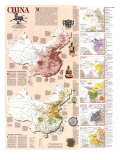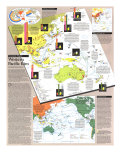The 1980 Peoples of China map features:
• An introduction to the diverse peoples of China with particular emphasis on the minorities
• A map showing the distribution of the five broad language groupings as well as the specific ethnicities
• Beautiful illustrations of many of the peoples of China including Han, Xinjiang, Mongol, Kazak, Tibetan, Dai, Kaoshan, and others
* Lesson plan idea - have your students update the information, discuss the political, economic, and environmental situations at time of publication and at date of their research. • maps
PEOPLES OF CHINA
BROCADED with many threads, the great robe of China is trimmed with various patterns at cuffs, collar, and hem. Border regions are embroidered with the homelands of most of China's 55 minority peoples. Though only 6 percent of the population, these groups number some 56 million and inhabit more than half of the country's territory, much of it deserts, steppes, or mountains.
The national minorities, as they are called in China, differ from the predominat Han Chainese in one or more of the following ways: language, customs, historical development, religion, race. They vary in numbers from 12,090,000 Zhuang to 600 Russians. Those pictured around the map represent most of the populous minorities, with a sampling of others to suggest their diversity. Though shown in traditional costumes, many daily wear such utilitarian garments ...
What was to become the Chinese empire grew from Neolithic settlements in the Yellow River Basin. Peoples on the empire's borders were simply and officially barbarians, and in the third century B.C. China built that most colossal artifact of policy toward those to the north: the Great Wall to keep them out.
With the Han Dynasty (206 B.C. to A.D. 220), China expanded into Central Asia and sent armies into Mongolia. Trade along the Silk Road reached as far west as Rome.
Chinese imperial fortunes rose and fell over the centuries, but even in eras of ascendancy no uniform policy governed the treatment of minorities. Those who were lowland farmers were absorbed by the Han majority (named ofr the dynastyL; others were taxed and their lands garrisoned. some paid only nominal tribute and allegiance, while still others retreated into remote mountain strongholds.
The Han majority was overrun by the Mongols under their khans (1260-1368). who did not adopt Chinese ways, and by the Manchu who, as the last dynasty (1644-1911), gradually adopted them.
Comprehensive policies for minorities issued after the Communist revolution include limited regional autonomy, training programs, freedom to develop native languages, and cultural and economic assistance. Use of the symbo for dog as part of written characters for ethnic names was abolished and the symbol for man substituted.
During the Great Leap Forward (1957-59) and the tumultous Cultural Revolution (1966-69), the rights of minorities were restricted. Rebellions were suppressed in Tibet in 1959 and in Xinjiang (Sinkiang) in 1962. In recent years the rights of minorities have been reaffirmed and their development accelerated. They have also been exempted from the national birth-control campaign.
These diverse peoples supply most of China's livestock, have in their territories most fo China's mineral resources, and inhabit China's borders with, among others, the Soviet Union and Vietnam. Often their kinsmen live across those national boundaries. Such factors argue for an even greater role of China's other peoples in the campaign for peaceful national development.
TIBETAN HIGHLANDS - Herders of yaks, sheep, and goats and farmers of barley, peas, and tubers, the Tibetans sparsely inhabit a high, desolate region surrounded by mountains and barricaded on the east by the canyons of the Yangtze, Mekong, and Salween Rivers. The advent of Buddhism in the seventh century led to a theocratic state intermettently controlled from China from the 13th century until 1959, when it took full power in the aftermath of a rebillion. Serfdom was abolished, government secularized, communes established, and mechanized agriculture and other modernizations begun. Surface transporation is as yet rudimentary; the first railroad may reach Lhasa in five to ten years.
XINJIANG - The Silk Road threading through Xinjiang's deserts and mountains carried China's trade westweard and eventually opened the way for Islam's expansion eastward. Seven of the 12 minorities here are Muslim, most of whom speak Turkic languages and for centuries used Arabic script. The Uyger, once called “high carts,” raise fruit, wheat, cotton, and rice by extensive irrigation. Their faces combine Indo-Iranian and Mongoloid features.
The Kazak, renowned for their horsemanship, and the Kirgiz, who keep Bactrain camels, have reduced their pastoral wanderings as herders of sheep and goats and live in communes during the winter. The Xibe, transplanted from the northeast as part of a border guard 300 years ago, are the largest single group of Manchu speakers in the country.
NORTH CENTRAL - The Mongol hordes of Genghis Khan and his successors swept s far as Vienna in the 13th century. Probably less than 10 percent of Inner Mongolia's people are Mongol today, but their population is increasing. Livestock, coal, iron, salt, steel, and grain are economically important, yet many Mongols remain seminomadic. They follow their flocks in summer, covering great distances and living in felt tents called yurts. Their yearly Nadam Fair features stock sales and contests of horsemanship, wrestling, shooting, and archery.
The Hui are esentially the same as the Han, except that they are Muslim, the Islamic religion having been introduced by Arab soldiers and merchants 1,200 years ago. The Hui are widely dispersed in many occupation, notably as butchers and restauranteurs. The Tu (Monguor) clans once served as frontier defenders for imperial China, which earned them limited local autonomy.
NORTHEAST - The Manchu, once herders and hunters, conquered China in the 17th century. They were gradually assimilated and are now found in all trades across the northeast, with little remaining of their ancienct customs or language. Only in the past 25 years, however, have the Oroqen and Ewenki begun giving up the birch-bark and hide tents of migrant hunters for a more settled life. They still hunt, but also breed deer, tend flocks and farm. Many now live in communes with warehouses, barns, and pens. The Daur have a tradtion of grain and vegetable farming and animal husbandry, as well as logging, hunting, and fishing. Korean immigrants have been filtering into China for centuries. Once rice growers, they have lately joined in the industrialization of Manchuria.
SOUTHEAST - Some minorities had been so absorbed that their status as separate peoples was nearly lost. Despite their numbers, the Tujia were not recognized until the 1950s. (The Jino of Yunnan in the southwest were only disignated a inority in 1979.) The Tujia farm rice and corn, gather fruit and fell trees for lumber, produce an oil made from tea, and are adept at handcrafts. The She, who now speak mainly Chinese, may be descended from the Yao who retreated to the west 500 years ago under pressure of Han expansion.
Kaoshan is a general term applied to the aboriginal mountain peoples of Taiwan: millet farmers, hunters of game, and until the early 20th century, hunters of heads. Their languages seem to stem from the Malayo-Polynesian group and may be the result of several migrations, perhaps from the mainland 4,500 years ago or from the Malay Archipelago.
SOUTH - Dispersed from southern Chinaacross northern Vietnam, Laos,and into Thailand, the Miao (Hmong)vary in dialect, styles of farming, and disignation: Black, White,Red, Blue, Flowery, and Cowrie Shell Miao among others. Forced southward by the Han, oten despised and exploited, manysettled in distant mountains, raising millet and buckwheat by slash-and-burn farming, their diet supplemented by domestic animals and hunting. Modernization–improved farming methods, organization of communes, road building–has been made difficult by the ragged terrain in which the Miao are scattered.
Native to the mountains of Hainan Island, the Li long had a history of rebellion against Chinese authority. In 1943 they rose against the Nationalist occupiers and were joined by local Communist guerrillas and later by the Chinese Red Army in the first large-scale collaboration of a minority during the civil war.
SOUTHWEST - Largest of the minorities, the Zhuang share with the Dai (ethnic kin to the people of Thailand) common linguistic roots and a love of festival singingand dancing. But unlike the more remote Dai, the Zhuang have had a close affiliation with the han for centuries. So, too, have the Bai, rice farmers from villages in the high plains of Yunnan, whose ancestors were among the original inhabitatns of the region.
Scattered in small stockaded villages in rugged mountains, the Yao raised rice, maize, and sweet potatoes by slash-and-burn farming. With the advent of better communications and transporation, they have a developing economy based on some hydorelectric power and increased irrigation. Fierce warriors, the Yi evolved an aristocratic society (even their slaves had slaves) and a religion based on the reading of sacred writings.










